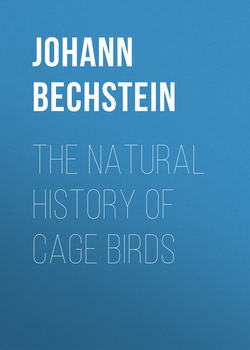Читать книгу The Natural History of Cage Birds - Bechstein Johann Matthäus - Страница 26
PIES
THE CUCKOO
ОглавлениеCuculus canorus, Linnæus; Le Coucou, Buffon; Der gemeine Kukuk, Bechstein
Although it is not larger than the turtle-dove, its length is fourteen inches, but seven of these are included in the tail, three quarters of which are covered by the folded wings. The beak, black above, and bluish beneath; the feet have two claws before and two behind. The head, the top of the neck, and the rest of the upper part of the body are of a dark ash colour, changing like the throat of the pigeon on the back and wing-coverts.
In the female, which is smaller, the upper part of the body is of a dark brown, with dirty brown spots, which are scarcely visible. The under part of the neck is a mixture of ash grey and yellow, crossed with dark streaks. The belly is of a dirty white, with dark transverse lines.
Habitation. – When wild, it is a bird of passage, which arrives in April and departs in September, and even much sooner, according to an English observer.
In the house, it may be let run about, or confined in a large wooden cage.
Food. – When wild, it eats all sorts of insects, particularly caterpillars on trees.
When confined, it is fed with meat, insects, and the universal paste made of wheat-meal.
Breeding and Peculiarities. – Every one knows that the female cuckoo never sits upon her eggs, but intrusts that care to other birds, particularly those which feed on insects, laying one or two eggs in their nest.
In order to tame a cuckoo, it must be taken from the nest: I never tried myself, but several of my friends have. As this is a curious bird, and most bird-fanciers like to have it in their room or aviary, I shall here insert some observations on this subject, by M. von Schauroth, who was before quoted.
“The cuckoo possesses hardly any qualities which would render it fit to be a house bird: if old, it is too obstinate and voracious, generally it is furious, sullen, and melancholy. I have reared several; the last was taken from the nest of a yellowhammer: its eyes were not opened when I took it, yet it darted at me with fury. Before I had had it six days it would swallow in a passion everything that came near it. I fed it on bird’s flesh, and was obliged to continue this food for a long time before it could feed itself. Its motions were so quick in jumping or moving that it would overthrow any cups of food which happened to be in its way. Its tail grew very slowly. It was never entirely tamed; it would dart at my hands and face, attacked every thing which came too near it, and even the other birds. It ate the poultry paste in great quantities, and discharged in proportion, which made it very dirty; I have even seen it, like the ostrich, eat its own excrements. Its short and climbing feet are so awkward that it cannot walk; it makes two or three jumps, but flies very well.”
“Though cunning and solitary,” says Buffon, “the cuckoos may be given some sort of education. Several persons of my acquaintance have reared and tamed them. They feed them on minced meat, either dressed or raw, insects, eggs, soaked bread, and fruit. One of these tamed cuckoos knew its master, came at his call, followed him to the chase, perched on his gun, and if it found a cherry tree in its way it would fly to it, and not return till it had eaten plentifully; sometimes it would not return to its master for the whole day, but followed him at a distance, flying from tree to tree. In the house it might range at will, and passed the night on the roost. The excrement of this bird is white, and in great quantities; this is one of the disagreeables in rearing it. Great care must be taken to keep it from the cold from autumn till winter; this is the critical period for these birds, at least it was at this time that I lost all which I had tried to rear, besides many other birds of a different species.”
